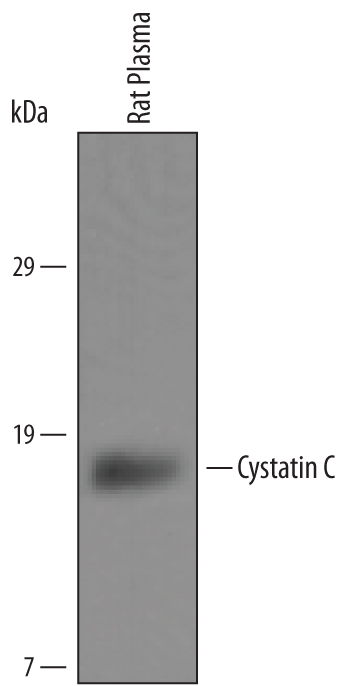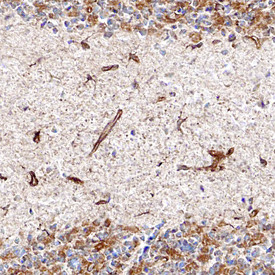Rat Cystatin C Antibody Summary
Met1-Ala140
Accession # P14841
Applications
Please Note: Optimal dilutions should be determined by each laboratory for each application. General Protocols are available in the Technical Information section on our website.
Scientific Data
 View Larger
View Larger
Detection of Rat Cystatin C by Western Blot. Western blot shows rat plasma. PVDF Membrane was probed with 1 µg/mL of Sheep Anti-Rat Cystatin C Antigen Affinity-purified Polyclonal Antibody (Catalog # AF6154) followed by HRP-conjugated Anti-Sheep IgG Secondary Antibody (HAF016). A specific band was detected for Cystatin C at approximately 16 kDa (as indicated). This experiment was conducted under reducing conditions and using Immunoblot Buffer Group 8.
 View Larger
View Larger
Cystatin C in Rat Brain. Cystatin C was detected in perfusion fixed frozen sections of rat brain (cerebellum) using Sheep Anti-Rat Cystatin C Antigen Affinity-purified Polyclonal Antibody (Catalog # AF6154) at 1.7 µg/mL overnight at 4 °C. Tissue was stained using the Anti-Sheep HRP-DAB Cell & Tissue Staining Kit (brown; CTS019) and counterstained with hematoxylin (blue). Specific staining was localized to neurons in the molecular layer of the cerebellum. View our protocol for Chromogenic IHC Staining of Frozen Tissue Sections.
 View Larger
View Larger
Detection of Rat Cystatin C by Simple WesternTM. Simple Western lane view shows rat plasma, loaded at 0.2 mg/mL. A specific band was detected for Cystatin C at approximately 28 kDa (as indicated) using 10 µg/mL of Sheep Anti-Rat Cystatin C Antigen Affinity-purified Polyclonal Antibody (Catalog # AF6154) followed by 1:50 dilution of HRP-conjugated Anti-Sheep IgG Secondary Antibody (HAF016). This experiment was conducted under reducing conditions and using the 12-230 kDa separation system.
Reconstitution Calculator
Preparation and Storage
- 12 months from date of receipt, -20 to -70 °C as supplied.
- 1 month, 2 to 8 °C under sterile conditions after reconstitution.
- 6 months, -20 to -70 °C under sterile conditions after reconstitution.
Background: Cystatin C
Cystatin C is a member of family 2 in the Cystatin superfamily (1). It is involved in processes such as tumor invasion and metastasis, inflammation and some neurological diseases. It inhibits many cysteine proteases such as papain and cathepsins B, H, K, L and S (2, 3). It is ubiquitous in human tissues and body fluids. A point mutation in the gene coding for the 120 amino acid mature Cystatin C causes a hereditary form of amyloid angiopathy in which the protein variant is deposited in the cerebral arteries, leading to fatal cerebral hemorrhage (4). Cystatin C may have additional clinical applications. For example, it is a good marker for glomerular filtration rate (5).
- Reed, C.H. (2000) British J. Biomed. Sci. 57:323.
- Janowski, R. et al. (2001) Nat. Struct. Biol. 8:316.
- Abrahamson, M. (1994) Methods Enzymol. 244:685.
- Abrahamson, M. et al. (1992) Hum. Genet. 89:377.
- Laterza, O.F. et al. (2002) Clin. Chem. 48:699.
Product Datasheets
FAQs
No product specific FAQs exist for this product, however you may
View all Antibody FAQsReviews for Rat Cystatin C Antibody
There are currently no reviews for this product. Be the first to review Rat Cystatin C Antibody and earn rewards!
Have you used Rat Cystatin C Antibody?
Submit a review and receive an Amazon gift card.
$25/€18/£15/$25CAN/¥75 Yuan/¥2500 Yen for a review with an image
$10/€7/£6/$10 CAD/¥70 Yuan/¥1110 Yen for a review without an image


